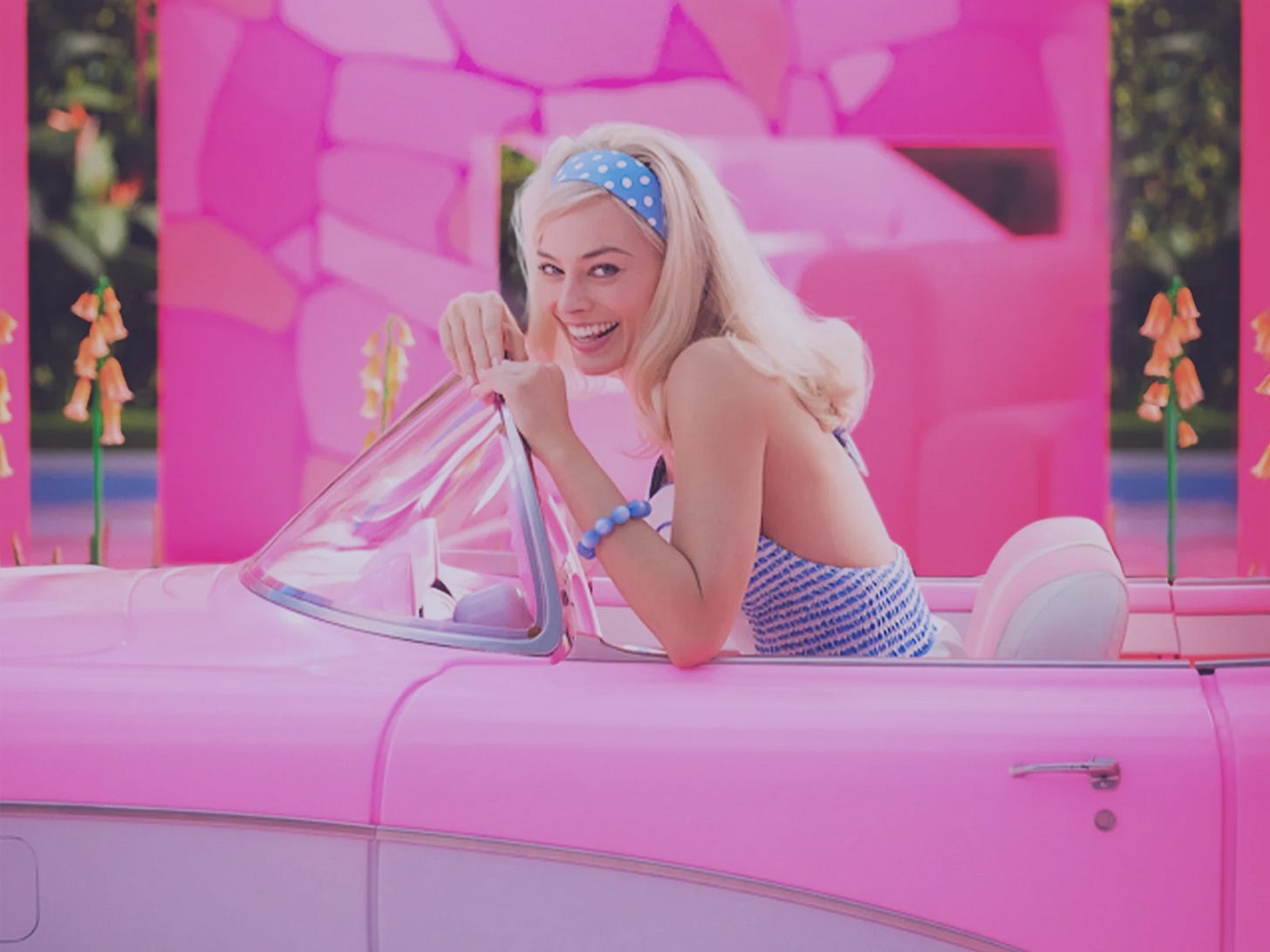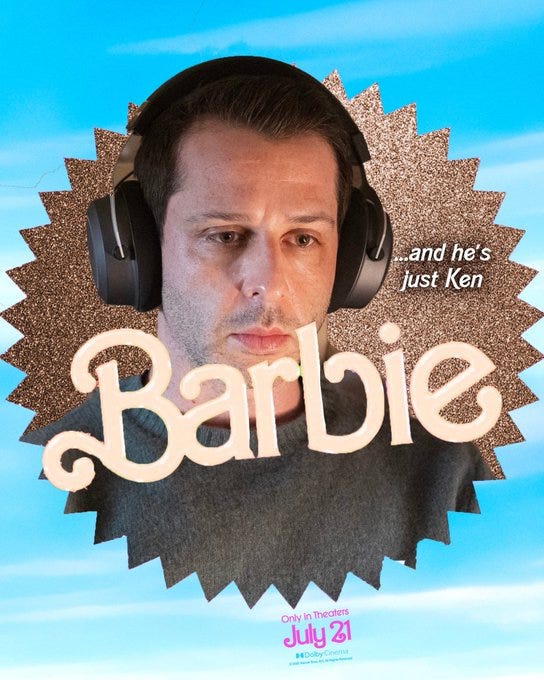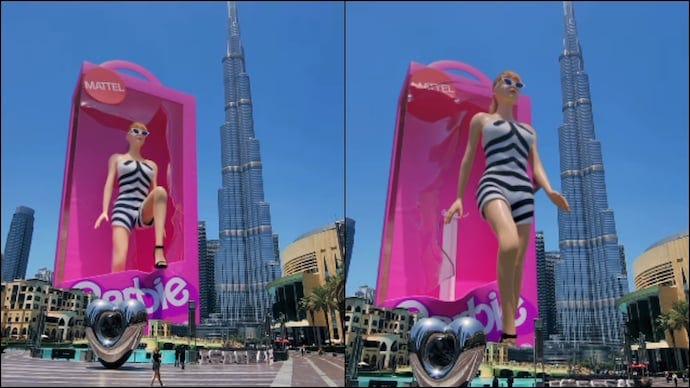From Barbie Doll to Disruptor
Unless you live in a dreamland or under a plastic toy box, you might’ve missed it. In case you hadn’t heard: Barbie is back. And she’s changing the marketing game with it.
I thought six months ago, when I started seeing pink advertising for Barbie in my social media feed, “this is going to be a bust.” Gosh, was I wrong. Barbie’s non-subtle marketing tactics over the last 12 months actually worked – and worked quite well. Barbie brought in $377M during its opening weekend this weekend, making it the biggest debut ever for a film directed by a woman and the top opening film this year.
The pink media parade, led by the marketing teams at Warner Bros. and Mattel, stormed nearly every industry: food & beverage, restaurants, clothing, shoes, accessories, makeup, interior design, gaming, pet supplies, movies, technology, online date – the list goes on. These efforts paid off in a major way, with the iconic Barbie brand movie capturing the top spot on the charts and enabling virality, using an estimated $150 million budget.
Barbie's triumphant return has revolutionized the marketing game, defying expectations and achieving remarkable success. This post delves into the key elements of Barbie's go-to-market strategy, offering valuable insights for brands. From creative partnerships and AI-generated marketing to emphasizing quantity, strategic timing, and user engagement, Barbie's journey serves as an inspiring blueprint for businesses navigating the digital age.
My thesis predicated on the marketing team’s thoughtful preparation, strategic branding, and tactful execution of various Barbie ad campaign strategies, including:
Creative Strategic Partnerships
Artificial Intelligence (AI) Generated Marketing
Emphasis on Quantity Over Quality
Strategic Timing
With that, let’s strut in.
Creative Strategic Partnerships
To start, one key strategy Barbie focused on was meeting potential viewers where they were at, both physically and digitally. To do this, Barbie first needed to understand who their target demographic was. Gleaning from audience data from PostTrak during opening weekend, we see that 65% of viewers were women and 40% of ticket buyers were under the age of 25. This tells us that their core demographic was younger women. Based on this, I grew interested how Warner Bros. reached them. The answer? Strategic partnerships.
Barbie cultivated relationships with over 100 partners that reinforced the brand and its movie debut. Barbie partnered with the following companies in the following industries:
Food: Swoon (pink lemonade), Pinkberry (frozen yogurt), Coldstone (ice cream), Di Martino (pasta – really going for it here), Burger King (makes sense)
Clothing: Pac Sun, boohoo, Forever 21, Hot Topic, Bloomingdale’s, Gap, Superga, Aldo, Crocs, Impala, MeUndies, Posh Peanut, and Spirit Halloween
Accessories: Chi and Mermade, Tangle Teezer, Kitsch, Hally, Fossil, Alex and Ani, Loungefly, Moon (toothbrushes), OPI (nail polish), Nyx (makeup), Truly (skincare)
Interior Design: Joybird (couches), Dragon (glassware), Ruggable (rugs), Homesick (candles)
Other: Funboy (pool floats, pink flamingos, makes sense), Beis (luggage), Xbox (not a bad idea), Uno (great game) Canada Pooch (dog clothing)
These partnerships are estimated to net Warner Bros. and Mattel at least $70 million. The publicity from these partnerships extends further than the dollars we can estimate; Barbie benefits from having been plastered all over the internet at least a half a million times since January, according to MuckRack data. Each page view, purchase, and physical product sitting inside someone’s home contributes to brand awareness.
We began seeing product placement in movies and shows more prominently over the last two decades. Popular examples are James Bond drinking Heineken, Marty McFly wearing self-lacing Nikes in Back to the Future, and Rod Tidwell getting rejected from Reebok ads in Jerry Maguire.
The differences between, what I’ll call the ‘classic’ version of strategic partnerships and the version that Barbie exemplifies is that the branding for Barbie was:
Both Digital and Physical
Social media engagement through generative AI and Bumble, which I’ll talk about later in the post, and physical product collaborations
At a Wider Scale
Partnered with multiple products and industries, not just a handful
Two-Sided
While I haven’t seen the movie, I presume the first way being ‘in-movie advertising’, like James bond, and the second way being ‘out-of-movie’ product branding
More Targeted
Targeted core demographic where they spend time: at yogurt shops, ice cream, and online
The takeaway? While most businesses don’t have a $150 million marketing budget like Barbie did, meeting core customers where they are can be advantageous in the long run. I’ll spend a bit more time on how Barbie captured user attention a little later.
AI Generated Marketing
Barbie went viral. While strolling through San Francisco and flipping through social media throughout opening weekend, I was surprised that both the background of my phone and eyes didn’t turn pink. The sea of pink stemming from coordinated pub crawls, group movie-viewings, and corporate decorations was hard to miss. The reason? Hard to say, though my hypothesis is that the Barbie marketing team was experimenting with generative AI.
The first AI-generated tool Barbie used was a website that let anyone create their own versions of Barbie’s iconic poster. The pilot program was primarily used as intended, though very quickly became a meme on social media. The second AI tool Barbie launched was a chatbot on Bumble that provided dating advice to users for an exclusive two-week period leading up to the film’s debut. Last, Barbie released a slew of content including pictures, quizzes, and videos that, in my view, were either created using AI or had some level of AI generation involved in the creative process.
I did a deep dive on the Bumble partnership and how it impacts Bumble’s business model and growth prospects, which I’ve linked to here, in case you’re interested in learning more about the partnership from Bumble’s side. For Barbie, they were able to lean on AI to create two bots, one as Barbie, the other Ken, to provide real-time, AI-generated advice to Bumble users for a limited time only, allowing users to engage with and reinforce the brand.
The results from these AI-generated marketing techniques appear to be a highly successful case study for entrepreneurs and corporations alike to consider for future go-to-market plans. As AI becomes more mainstream, understood, and woven into the fabric of society, those that embrace the technology may be the ones to benefit from it.
Emphasis on Quantity Over Quality
The premier of Barbie showcased the mantra: quantity over quality. With over 100 partnerships, thousands of articles related to the movie, and countless instances of engagement on social media, the market team capitalized on dominating what I like to call eyeball market share of an individual’s attention.
Each individual has 24 hours in a day, and, when removing sleep and work from those hours (let’s guesstimate that to be 16 hours on average), you are left with 8 hours of free time. According to recent data, the average person spends 3 hours and 15 minutes on their phone each day. If we follow that average, the eyeball market share is the share of time of that 3 hours and 15 minutes that people devote their attention to. For example, users may spend an hour on Instagram, an hour and a half on TikTok, thirty minutes on Snap, and the rest on iMessage, music, etc. That means that Instagram has 31% eyeball market share (60 minutes divided 195 total average minutes), TikTok has 46%, etc.
The marketing team at Barbie focused on casting their net on the internet as far and wide as possible in order to increase their eyeball market share for the movie. They knew that by capturing user attention, they would be afforded the chance to sell to them directly (via having them become knowledgeable of the brand and perhaps watch the movie, talk about the movie on social media, or purchase some affiliated product) or indirectly (leverage the user as a marketing billboards if they engaged)
Barbie’s quantity over quality strategy was defined by how far and wide they could spread the word. To them, if they could get in front of as many businesses, users, and potential customers as possible, then they would try. They de-emphasized the quality of each partnership, arrangement, and action – let’s say, a social media post for example – and, from my perspective, concentrated on quantity. The rationale for emphasizing breadth of advertising was to take eyeball market share away from other brands and then force those eyeballs to decide how they want to engage with Barbie.
Strategic Timing
The marketing strategy at Barbie was timely. The premier was during the summer, when most sports are in various off- and mid-seasons and when the weather is idyllic as is often portrayed in Barbieland. More importantly, the timing of the various ad strategies were staged over the preceding twelve month period.
Starting at CinemaCon in 2022, an image of Barbie in her Corvette in Barbieland struck a cord with viewers at the event. From then on, the marketing team launched a breadcrumb strategy to slowly reveal more over time. Earlier this year, in April, a highly successful trailer debuted. One of the biggest appeals of the entire marketing campaign was to conveniently de-emphasize answers to the inevitable questions around, ‘What’s the movie about?’
Barbie’s marketing team also used clever, limited time offerings for products and services, including the two-week exclusive opportunity leading up the U.S. premier of the film to get advice from Barbie and Ken on Bumble. Warner Bros. continued to experiment with other forms of clever, tech-focused marketing tactics such as using CGI to create a 3D Barbie advertisement in front of Burj Khalifa in the United Arab Emirates (where Barbie is set to be released on August 31).
What can we learn from Barbie’s timing strategy? Being thoughtful about when and where to place ads, and providing a sense of ‘exclusivity’ for campaigns, can help create and maintain buzz. Marketing teams looking to take a page out of Barbie’s book should take note of the level of depth of planning – at least twelve months in advance – for a drip, breadcrumb-style ad campaign.
Conclusion
Describing what Barbie has done is nothing short of impressive. To smash box office records during a time when (i) there are talks of a recession, (ii) inflation is at near all-time highs, and (iii) online streaming nearly destroyed the movie theater industry is truly spectacular. There are many lessons to take away from what and how Barbie did what they did. By adopting AI-generated marketing, meeting core customers where they spend their time, emphasizing quantity, and carefully timing campaigns, brands can position themselves for success in an ever-evolving marketing landscape.
Barbie's marketing strategy exemplifies the power of embracing new technologies, creative partnerships, and strategic planning to disrupt traditional marketing norms. Barbie's journey from doll to disruptor serves as a compelling example of how innovation, strategy, and adaptability can lead to outsized marketing achievements.








